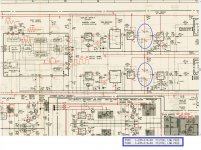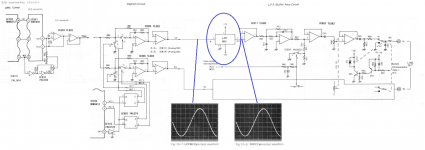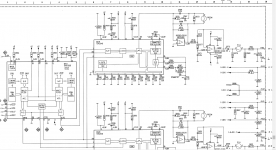I need to get a job at Office Depot so when I interview for an engineering job I can say "In my current position I'm pushing the envelope."
a really classy vinyl playback system with at least a $2500 MC phono pickup. Everything else is too compromised to evaluate hi end audio systems.
Price = quality? I would say "Adulation without examination is prejudice"
I tried some more tests with possibly more realistic signals. More importantly I actually listened to the 20k, 16k sum which had a 4k envelope and could hear nothing so I don't see how the presence or absence of the 24k could make a difference. I know at lower frequencies the signal envelope can be perceived.
You seem to have used sin(4k)*cos(20k), correct ?
Although mathematically correct, it is just the sum of 16Kz and 24Khz signals.
Audio signals add and do no multiply to my opinion, so talking about 20khz and 4khz seems confusing, because after filtering both frequencies are gone as by magic, while in fact only the 24k is filtered and the 16k remains.
Hans
I think it is time to reintroduce this link:
Human hearing beats the Fourier uncertainty principle
"The top score, achieved by a professional musician, violated the uncertainty principle by a factor of about 13, due to equally high precision in frequency acuity and timing acuity. The score with the top timing acuity (3 milliseconds) was achieved by an electronic musician who works in precision sound editing."
I am sure I do not have good enough loudspakers currently, other priorities taking my time money and attention, but it does point to some very good reasons to go beyond 20K even if the ears not hear the notes directly.
Human hearing beats the Fourier uncertainty principle
"The top score, achieved by a professional musician, violated the uncertainty principle by a factor of about 13, due to equally high precision in frequency acuity and timing acuity. The score with the top timing acuity (3 milliseconds) was achieved by an electronic musician who works in precision sound editing."
I am sure I do not have good enough loudspakers currently, other priorities taking my time money and attention, but it does point to some very good reasons to go beyond 20K even if the ears not hear the notes directly.
Yesterday noon, I made the mistake to play back (low volume) through loudspeakers this link.
YouTube
My cat who was two meters above the loudspeakers (usually relaxed, doesn’t blink an eye with soprani and tenori high SPLs) went nuts.
He was looking frightened in all directions for an enemy, then started running up-down the stairs, hide under sofas and beds.
I turned the youtube channel off, the cat remained upset for about 2 hours. He didn’t eat and drink but late in the night.
The loudspeakers were two LS3/5A clones
George
Scheisse, you did it to me too

Solving it by simply going to higher rates is not what I meant.
I am surprised that I could not find any published literature on the possibility of modulation sidebands hitting the brick wall. Lord knows, I did an awful lot of googling to find it..
jn
Since much can be found on the internet about all kinds of things and beings that do not even exist, draw your own conclusions.
I would have thought the physical size would have been determined more by the track widths and the ability of the reader and associated electronics of the day (development took place in the early 1980’s and leveraged the laserdisc technology as well) to track with low bit rate errors.
CD’s cost 2x LP’s for the first few years and besides the ROI requirements, justified because you could fit more material onto a CD.
The ‘brand’ guys at both companies of course could have spun this with the Beethoven story.
Indeed there must have been overriding technical limitations one of those along the way being limiting frequency response via insufficient Nyquist , and very much admission of that by the use of brickwall filters, in order to achieve at the time FR to 20Khz, caused by the formats small size. The format size restrictions are no longer present to provide better technical ability, but technical ability with FR of the format has sadly not improved.
But the story with Herbert Von Karajan has some truth to it, as Sony consulted with Karajan where apparently a gathering at the 1981 Salzberg music festival listened to Sony CD's. Karajan then giving support to the format. Karajan also gave a performance of Giuseppe Verdi Falstaff Salzburg Festival / History 1981
Well, the MC phono pickup that we used last Saturday along with some other equipment, costs approximately $10,000. I personally only use the $2500 version from earlier years from the same manufacturer. It is important to have the best in the chain to seriously evaluate quality audio equipment, or else it will tend to sound just the same as anything else.
Thank you for the link.
Hans
Here is a first pass on the delay line network. The cap values for the panels are guesses. I'll have a panel here to measure in a few days i hope and can then update the sim. I'm certain there are other errors but its a start.
Attachments
BTY I was at the AES convention when the CD standard was passed. I didn't run into anyone who thought the high frequency limit was wonderful. The attitude was we got a standard passed that folks could actually build.
Virtually all the original converters used multistage LC filters. I tried looking up the data sheet for the single can multipole filters that were mass produced for the early CD players. No luck
Ed, no luck.
It’s in the schematics of the early (mid 80ies) Japanese CD players as a building block, no internals shown, no other information found.
But it seems they were not passive circuits, as the block shows connection for signal input, signal output, +/_
I can’t find them in any European or American brand CD player .
George
Attachments
Get a western antidote (pour in some malt) 😀Scheisse, you did it to me too
George
Here is a first pass on the delay line network. The cap values for the panels are guesses. I'll have a panel here to measure in a few days i hope and can then update the sim. I'm certain there are other errors but its a start.
That’s great. But cap value for the panels are way too high.
I guess in total between 1nF and 1.5nF.
I’ll show you the calculation tomorrow.
Hans
You seem to have used sin(4k)*cos(20k), correct ?
Although mathematically correct, it is just the sum of 16Kz and 24Khz signals.
Audio signals add and do no multiply to my opinion, so talking about 20khz and 4khz seems confusing, because after filtering both frequencies are gone as by magic, while in fact only the 24k is filtered and the 16k remains.
Hans
No, yesterday I suggested some simple AM modulation tests. This was 20k modulated by 4k well under 100%, so there is 16k, 20k, 24k in the spectrum.
I could not hear anything with or without the 24K.
I don't understand the confusion you have a computable spectrum it does not matter if you add up the individual components or do the multiplication. Which brings up the issue of the phase of the components and AM vs FM more to worry about.
I think it is time to reintroduce this link:
Human hearing beats the Fourier uncertainty principle
Fourier theory is a mathematical construct relating the time to frequency domain. It makes no testable hypotheses concerning the mechanism of human hearing.
I think you are misinterpreting the findings.I think it is time to reintroduce this link:
Human hearing beats the Fourier uncertainty principle
"The top score, achieved by a professional musician, violated the uncertainty principle by a factor of about 13, due to equally high precision in frequency acuity and timing acuity. The score with the top timing acuity (3 milliseconds) was achieved by an electronic musician who works in precision sound editing."
I am sure I do not have good enough loudspakers currently, other priorities taking my time money and attention, but it does point to some very good reasons to go beyond 20K even if the ears not hear the notes directly.
It has nothing to do with high frequencies but with the ability to recognize a frequency.
When you only have a part of a sine wave that becomes shorter and shorter, there comes a point where Fourier is no longer capable of determining the frequency, while humans are still able to go beyond this point.
Hans
O.k. Thanks.No, yesterday I suggested some simple AM modulation tests. This was 20k modulated by 4k well under 100%, so there is 16k, 20k, 24k in the spectrum.
Hans
I think you are misinterpreting the findings.
It has nothing to do with high frequencies but with the ability to recognize a frequency.
When you only have a part of a sine wave that becomes shorter and shorter, there comes a point where Fourier is no longer capable of determining the frequency, while humans are still able to go beyond this point.
Hans
Can a human determine the frequency of a sinus without the sinus completing a full 360 turn?
//
Can a human determine the frequency of a sinus without the sinus completing a full 360 turn?
//
Yep, so it seems, depending on the frequency 😀
Hans
Fourier theory is a mathematical construct relating the time to frequency domain. It makes no testable hypotheses concerning the mechanism of human hearing.
I think you are misinterpreting the findings.
It has nothing to do with high frequencies but with the ability to recognize a frequency.
When you only have a part of a sine wave that becomes shorter and shorter, there comes a point where Fourier is no longer capable of determining the frequency, while humans are still able to go beyond this point.
Hans
I hope we could discuss this a little further.
Although the ear translates incoming sound into a representation in the frequency domain, it does so in a very different way than a Fourier conversion. Roughly speaking, the ear consists of an array of tuned mechanical resonators, outputting the intensity of sound in specific frequency bands. 3.500 or so in the human inner ear.
A most remarkeable difference with a Fourier transform is that a Fourier transform requires a window that is at least wide enough to capture the lowest frequency of interest. And because the window is wide, temporal information on higher frequencies gets lost. Or rather, temporal resolution is lost.
And this is not the case with an array of mechanical resonators. Here, each resonator is windowed by its own Q in its own time frame. In other words, low frequencies can be distinguished without loss of temporal resolution of higher frequencies.
Therefore, the ear is far superior to Fourier when it comes to extracting useful information from sound by converting it from the time into the frequency domain.
Last edited:
- Home
- Member Areas
- The Lounge
- The Black Hole......



